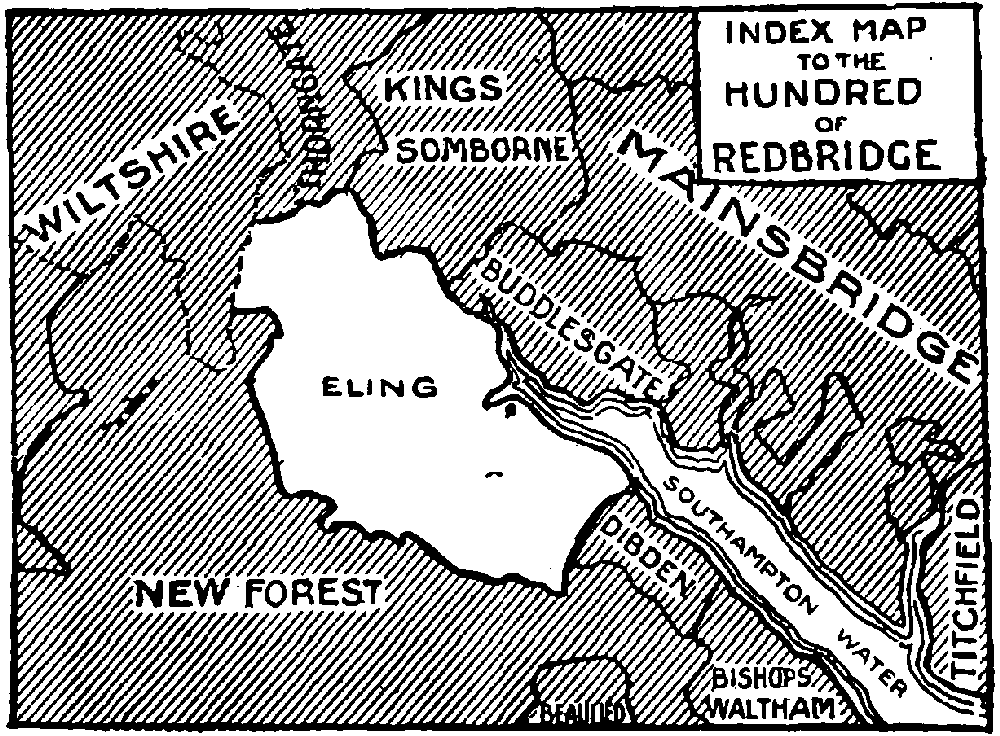A History of the County of Hampshire: Volume 4. Originally published by Victoria County History, London, 1911.
This free content was digitised by double rekeying. All rights reserved.
'The hundred of Redbridge', in A History of the County of Hampshire: Volume 4, (London, 1911) pp. 544-545. British History Online https://www.british-history.ac.uk/vch/hants/vol4/pp544-545 [accessed 18 April 2024]
THE HUNDRED OF REDBRIDGE
containing the parish (fn. 1) of; Eling
At the time of the Domesday Survey the hundred of Redbridge (Rodbrige, xi cent.) included the parishes of Eling, Fawley, Dibden, Oakley (fn. 2) in Mottisfont, 'Hariford' (perhaps Hartford in Beaulieu), Otterwood in Beaulieu, 'Gatingeorde' (perhaps Gatewood in Exbury), ' Titegrave' (perhaps Tidgrove in Kingsclere) and 'Roweste' and 'Northam,' which have not been identified. (fn. 3) In 1316 only Eling, Dibden and Stone in Fawley remained in the hundred. (fn. 4) Stone was transferred between 1831 (fn. 5) and 1841 to Dibden Liberty, (fn. 6) in which the rest of the parish of Fawley is now situated. Wigley has always formed part of Thorngate Hundred. (fn. 7) Cadnam also, which lies partly in the parish of Eling and partly in that of Minstead, has always been in the hundred of Thorngate. (fn. 8)

Index Map to the Hundred of Redbridge
Dibden was assessed apart from the hundred in 1544 to 1546. (fn. 9) After 1570–1 Dibden appears as a liberty (fn. 10) and became entirely separated from Redbridge Hundred. (fn. 11)
Lyndhurst, Minstead and part (fn. 12) of Bramshaw were transferred from the New Forest and Nursling from Buddlesgate Hundred to this hundred between 1831 and 1841. (fn. 13)
William de Valence obtained immunity from suit at the hundred court in the 13th century for Hoke and Strete. (fn. 14)
A survey of the hundred was taken in 1651. (fn. 15) The court leet and law day were held twice yearly at Hocktide and Martinmas, either at Totton or Lyndhurst, as were the three-weekly hundred courts. In the tithing of Eling it was the custom for the last taker of any land there to do the service of tithingman. The steward for the courts was usually appointed by the Warden of the New Forest, who was also, as a rule, the owner of the hundred for the time being. The bailiff was appointed by the sheriff of the county. (fn. 16)
Redbridge was a royal hundred, but was several times given in dower to the queens consort of England or otherwise granted out by the Crown, and in this way was granted to Eleanor (fn. 17) (in 1279) and Margaret (fn. 18) (in 1299), consorts of Edward I; Isabella consort of Edward II in 1318, (fn. 19) Philippa consort of Edward III in 1331, (fn. 20) who granted it to Thomas West in 1333 (fn. 21) and John de Beauchamp about 1343. (fn. 22) The king confirmed it to John de Beauchamp in 1359–60, (fn. 23) and granted it to Richard de Pembrugg in 1360–1 (fn. 24); to Sir John de Foxle in 1372–3 and 1376 (fn. 25); to Edward Duke of York in 1397; to Sir Edward Courtenay in 1415; and to Thomas Earl of Salisbury in 1418. (fn. 26) It was granted to Humphrey Duke of Gloucester in 1428, and in 1441 to William de la Pole Earl of Suffolk on the death or cession of Duke Humphrey. (fn. 27) The duke held it until his death in 1446–7, (fn. 28) and it was granted in 1461 to William Fiennes Lord Say and Sele, who surrendered it in 1467 to William Earl of Arundel, to whom a grant of the hundred was made for life with remainder to Sir Thomas Arundel and his heirs male by Margaret his wife. (fn. 29) This grant was confirmed in 1490 to Thomas, then Earl of Arundel. (fn. 30) No further grants of the hundred have been found until 1624, when it was granted to the Earl of Pembroke during the minority of the Earl of Southampton, by whose father the hundred had formerly been held. (fn. 31) In 1668 a warrant was issued for a grant of the hundred to Charles Lord St. John de Basing, (fn. 32) and in 1689 it was confirmed to him as Marquess of Winchester. (fn. 33) Presumably in the next century it reverted to the Crown, by whose appointment the office of steward of the hundred of Redbridge and the manor of Lyndhurst is held. (fn. 34)
